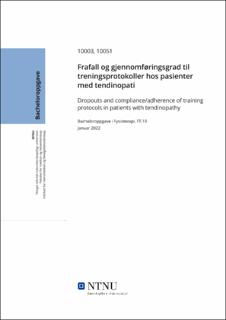| dc.contributor.advisor | Bentsen, Lennart | |
| dc.contributor.author | Aamo, Aleksander | |
| dc.contributor.author | Berge, Andreas | |
| dc.date.accessioned | 2022-04-29T17:19:18Z | |
| dc.date.available | 2022-04-29T17:19:18Z | |
| dc.date.issued | 2022 | |
| dc.identifier | no.ntnu:inspera:100599577:101708472 | |
| dc.identifier.uri | https://hdl.handle.net/11250/2993485 | |
| dc.description.abstract | Bakgrunn og hensikt: På bakgrunn av at litteraturen tilsynelatende viser lik effekt blant ulike tendinopatiprotokoller, var hensikten med litteraturstudien å undersøke pasienters frafall og gjennomføringsgrad tilknyttet de ulike protokollene, samt kartlegge nytteverdien protokollene har for den enkelte pasient.
Metode: Systematisk oversiktsartikkel med søk i databasene: «PubMed», «SPORTDiscus», «PEDro», og «Medline». I tillegg ble det gjennomført manuelle søk i referanselistene til inkluderte studier og relevnate oversiktsartikler, samt siteringssjekk i «Google Scholar».
Resultat: Totalt 12 studier ble inkludert; 11 randomiserte kontrollerte studier og 1 ikke-randomisert. Primærfunnene viser at det er liten forskjell mellom de ulike protokollene: HSR, EE, og Silbernagel, i henhold til frafall (EE, 10,1%; HSR, 8,84%; Silbernagel, 3,3%) og gjennomføringsgrad (EE, 49-78%; HSR, 49-92%; Silbernagel, 40% og 77,3%). Av de forskjellige årsakene til frafall var det to kategorier som oftest gikk igjen: «forverring av symptomer», og «dårlig tid», med 7 og 8 tilfeller respektivt.
Konklusjon: Basert på de viktigste funnene i litteraturstudien kan vi påstå at protokollene er et godt alternativ for pasienter med tendinopati. Derimot fant vi at det er flere pasienter som, med bakgrunn i barrierer, ikke klarer å gjennomføre protokollene i sin helhet. Med hensyn til de sprikende funnene vedrørende frafall og gjennomføringsgrad, kan vi påstå at protokollene passer bedre for enkelte pasienter, som underbygger viktigheten av å tilpasse rehabiliteringen etter pasientens situasjon og preferanser. | |
| dc.description.abstract | Background and purpose: Based on the fact that the effect among different tendinopathy protocols seems to be similar, the purpose of the literature study was to examine patients' dropout rate and degree of implementation associated with the various protocols, and to evaluate the usefulness of the protocols for the individual patient.
Method: Systematic review with searches in the databases: «PubMed», «SPORTDiscus», «PEDro», and «Medline». In addition, searches were performed manually in the reference lists of included studies and relevant systematic reviews, as well as examining citations in «Google Scholar».
Results: A total of 12 studies were included; 11 randomized controlled trials and 1 non-randomized. The primary findings show that there is little difference between the different protocols: HSR, EE, and Silbernagel, according to dropout (EE, 10.1%; HSR, 8.84%; Silbernagel, 3.3%) and compliance/adherence (EE, 49-78%; HSR, 49-92%; Silbernagel, 40% and 77.3%). Of the various causes of dropout, there were two categories that most often recurred: «aggravation of symptoms», and «lack of time», with 7 and 8 cases respectively.
Conclusion: Based on the most important findings in this systematic review, we can claim that the protocols are good alternatives for patients with tendinopathy. On the other hand, we found that there are several patients who, due to barriers, are unable to implement the protocols in their entirety. On the basis of the divergent findings regarding dropout and compliance/adherence, we can claim that the protocols are better suited for some patients, which supports the importance of adapting the rehabilitation to the patient's situation and preferences. | |
| dc.language | nob | |
| dc.publisher | NTNU | |
| dc.title | Frafall og gjennomføringsgrad til treningsprotokoller hos pasienter med tendinopati | |
| dc.type | Bachelor thesis | |
